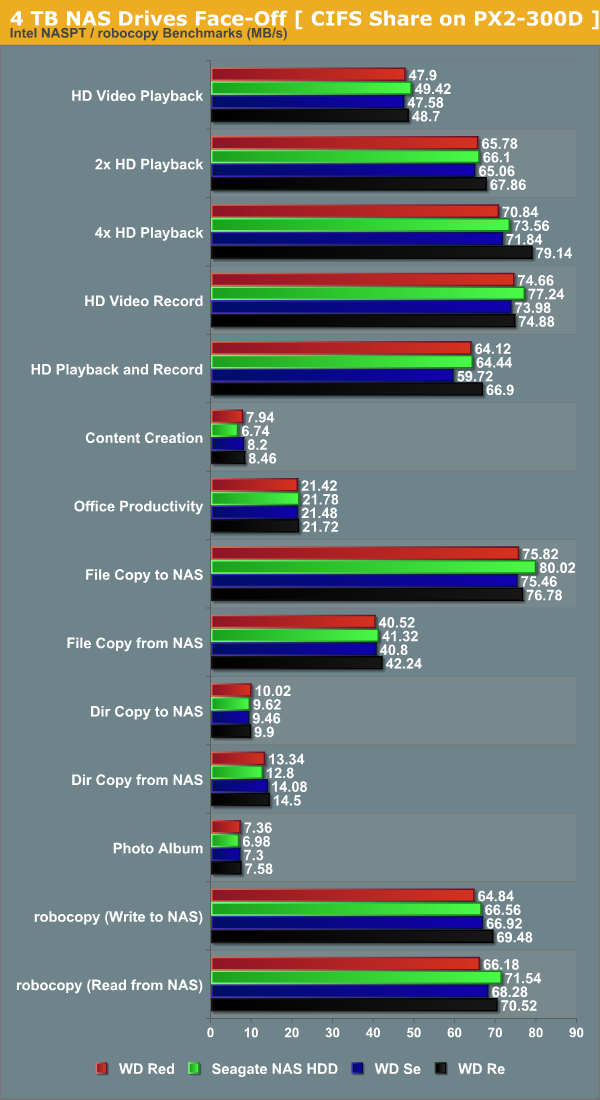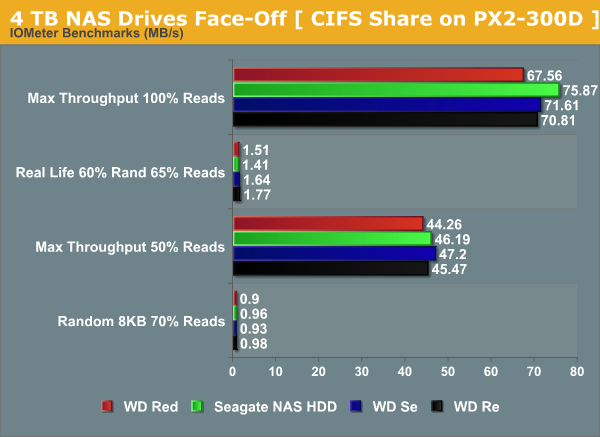Battle of the 4 TB NAS Drives: WD Red and Seagate NAS HDD Face-Off
by Ganesh T S on September 4, 2013 6:00 AM EST- Posted in
- NAS
- Seagate
- HDDs
- Western Digital
- Enterprise
Performance - Networked Environment
LenovoEMC's PX2-300D (based on the Intel Atom D525) was used as the testbed for evaluating the performance of the drives in a NAS enclosure. The PX2-300D is a 2-bay NAS unit. Only JBOD, RAID-0 and RAID-1 configurations are possible. Due to the lack of multiple samples of the Seagate NAS HDD, we restricted ourselves to evaluating a single disk configuration (JBOD) over the network A CIFS share was set up on the NAS and mapped on a Windows 7 VM. Intel NASPT / robocopy as well as IOMeter traces were run on this CIFS share.
Intel NASPT / robocopy

As expected, the WD Re takes the lead in many of the benchmarks. However, the Seagate NAS HDD is no slouch, and actually manages to hold its own in most of them (in fact, the read performance is pretty decent in this configuration).
IOMeter

IOMeter provides even more interesting results. The Seagate NAS HDD actually surpasses the WD Red in three of the four benchmark runs. That said, performance is only half the story in the 1-5 bay NAS market. Power consumption is also a very important metric. How much of a penalty do we have for the increased performance? The next section provides us some answers.










54 Comments
View All Comments
Rick83 - Wednesday, September 4, 2013 - link
I think the Re at least is only relevant when you are space or controller constrained, as otherwise getting a second cheaper disk is probably going to give better speed and reliability on average.Generally, I'd have preferred a comparison with the cheaper drives, as I don't see the point of spending more on something that will probably have the same observed failure rates in real usage, and will saturate Gbit LAN when streaming
Of course, if you commit to only a 2-bay NAS, then it might pay off to go with disks with slightly tighter tolerances and more thorough QA, but once you hit 4+ bays, there's rarely a reason to not just throw redundancy at the problem.
colleenames - Thursday, September 5, 2013 - link
hyVMguy - Wednesday, September 4, 2013 - link
Excellent review. Very helpful for allowing us to select drives to target specific workloads in smaller (or budget constrained) environments.Are you planning to continue this style of review with other ESATA/SAS drives such as the Constellation.2? Those drives seem to enjoy wider OEM support and are in the same price range as the Se/Re.
Thanks!
VMguy - Wednesday, September 4, 2013 - link
Er, sorry. that should have read Constellation ES.3edlee - Wednesday, September 4, 2013 - link
I wish you did a temperature torture test, would have loved to see the results.arthur449 - Wednesday, September 4, 2013 - link
Running the hard drive(s) at temperatures beyond their stated maximum simply decreases their lifespan; it won't cause a dramatic failure or lead to an escape scenario for the magic smoke within the drive. At least, not for the duration that Ganesh T S devoted to this comparison.tuxRoller - Wednesday, September 4, 2013 - link
I thought Goggle's data showed this (higher temperature implies lower lifecycle) to be false?bobbozzo - Thursday, September 5, 2013 - link
Google said that temperature variations WITHIN A NORMAL DATACENTER ENVIRONMENT did not noticably affect drive failure rates.e.g. none were overheating.
dingetje - Wednesday, September 4, 2013 - link
would like to see the plattercount of the 4tb red confirmedganeshts - Wednesday, September 4, 2013 - link
Confirmed to be four 1 TB platters.